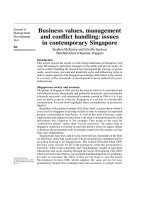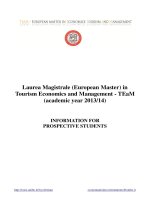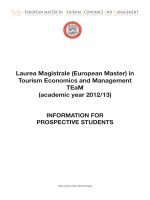Contemporary Issues in Tourism. LGBT Tourism.
Bạn đang xem bản rút gọn của tài liệu. Xem và tải ngay bản đầy đủ của tài liệu tại đây (61.94 KB, 5 trang )
Contemporary Issues in Tourism
LGBT tourism
In recent years, tourism and its related economic influences have taken place
within a wider context of gay and lesbian tourism that also refer to queering
tourism. The World Tourism Organization classifies queering tourism as a type
of niche market, target on gay and lesbian, about their sexual preference who
seeks to travel to destinations that are LGBT-friendly (lesbian, gay, bisexual,
transgender) in order to participate in activities that embraces the homosexual
lifestyle. Regarding to special market position, LGBT tourism is increasingly
becoming a concentration of many tourist destinations and moreover, there are
also a number of advantages that may be derived from gay and lesbian tourism [
CITATION Jef07 \l 5129 ].
The majority of LGBT community consists of SINKs and DINKs means single
or double income with no kids; thus they have more money and time for
travelling [CITATION Aus13 \l 5129 ]. Moreover, LGBT consumer considered
as upper class customers and have high demand in personal service; thus they
are often targeted to high end item, including luxury travel, gourmet foods
[ CITATION Ken12 \l 5129 ]. According to Travel Industry of America, gay and
lesbian couples have more travel habitual than straight couples, as 85% of the
GLBT community travels for the holiday at least once each year [ CITATION
Jef07 \l 5129 ].
In addition, a recent study show that the destination choice is very important
because they need to travel to the safe place where no discrimination against
gay and lesbian tourist. As one of the most gay-friendly countries in the world,
USA is an attractive destination for gay and lesbian tourists [ CITATION
Mel14 \l 5129 ]. In early 2014, among the top 20 markets for lesbian, gay,
bisexual and transgender, USA is the most profitable country from LGBT
spending, with approximately USD56.5 billion [ CITATION LGB13 \l 5129 ].
Another example is about American Airlines, known as the leader in actively
1
Contemporary Issues in Tourism
target the LGBT market and now generates a million dollars in revenue from the
segment [CITATION Ame13 \l 5129 ]. In terms of American Airline’s position,
they have significant sustainable competitive advantages compared to other
airlines that also adopting a strategy of targeting the LGBT segment thereafter
[ CITATION Pur09 \l 5129 ].
The lesbian and gay tourism not only impact on the country’s economy, but
more specifically, the regional economy also affected. The issue will be
examined in case of the Castro - San Francisco’s gay and lesbian center. The
Castro represents for an economic success that brings profit all year around with
many events served to the LGBT network along with everyday business.
Besides, the economic impact of queering tourism is widespread creating a new
economic opportunity for local tourism and hospitality. For over 40 years, the
number of restaurants in the Castro had risen 214%, and a lot of commercial
places have opened for people who identify as homosexuality. These
establishments lead the Castro to higher spending and high tourist traffic, in
which not only local residents are going to the streets, but foreigner also come
to visit the Castro [ CITATION Boy11 \l 1033 ].
Furthermore, according to gaytravel.com, the best event of the LGBT
community is Sydney Mardi Gras. This event encourages the participation of
LGBT community and straight people as well; hence it makes a significant
contribution to the local economy and indirect influence on the global economy
through tourism suppliers [ CITATION Lyn05 \l 5129 ]. There is a fact that the
Sydney Mardi Gras event not only is not affected by the economic recession,
but conversely, the event is beneficial for the local economy. Consequently,
Sydney Mardi Gras is getting larger each year and attract a lot of visitors as well
as earning profit from growing tourism market [ CITATION Mar02 \l 5129 ].
In social terms, the legal recognition of LGBT or the same sex marital as well
has not only created a powerful factor on increasing LGBT tourist, but also raise
2
Contemporary Issues in Tourism
the awareness of gender issue and the more important is an image of tolerance,
respect [CITATION Wor12 \l 5129 ]. Indeed, there is a perspective that the
LGBT community, not just examine by their sexuality, age, social class but their
social responsibility. In the world of travel and tourism, LGBT consumer
considers as a meaningful market segment [ CITATION Jea13 \l 5129 ].
Specifically, as an example of Sydney Mardi Gras event with the bigger scale
each year. The event is an evidence for Sydney people’s attitude toward gay and
lesbian tourist. Every year, all visitors come to the event, gather together to
celebrate and offering gays and lesbians a chance to express their opinion to
societies. This kind of tourist activity provides the positive impact not only for
Australia’s image, but it is also an opportunity for LGBT to identify themselves
and raise the development of the community [CITATION Wor12 \n \l 5129 ].
To conclude, LGBT tourism has been marked to play an important role in the
socio-economic development. Regarding to social impacts of tourism, positive
aspects of LGBT tourism are raising conscious efforts on social awareness and
the mutual understanding among the societies. Even more, beyond social
benefit, lesbian and gay tourism as one of the fastest growing niche markets in
the world, also quite resistant to economic turbulences and contribute a huge
amount of profit to the world economy.
References
3
Contemporary Issues in Tourism
American Airlines. (2013). American Airlines LGBT Policies, Practices and
Community Recognition at a Glance. Retrieved from
/>Australia's gay & lesbian media specialists. (2013, 6 18). Retrieved from Pink
media group Web site:
/>proof_18_june_2013_v3.pdf
Boyd, N. A. (2011). San Francisco's Castro district: from gay liberation to tourist
destination. Journal of Tourism and Cultural Change, 237-248.
doi:10.1080/14766825.2011.620122
Guracino, J. (2007). Gay and Lesbian Tourism. Elsevier/ButterworthHeinemann.
Jean-François, R. (2013). Report for ITB Berlin. ITB Corporate Social
Responsibility. Retrieved from />_business_travel_day/8_03_13_destination_day_3/gay___lesbian_travel
/itb2013lgbt_presentationcmi2013_mixitb.pdf
Johnston, L. (2005). Queering tourism : paradoxical performances at gay pride
parades. New York: Routledge.
Kiesnoski, K. (2012, 5 22). With a big-spending reputation, gay travelers attract
suppliers. Retrieved from Travel Weekly Web site:
/>LGBT Tourism Breaks Through USD$200 Billion in Annual Spending. (2013, 11
6). Retrieved from World Travel Market Web site:
4
Contemporary Issues in Tourism
/>2343/listID=1
Markwell, K. (2002). Mardi Gras Tourism and the Construction of Sydney as an
International Gay and Lesbian City. A Journal of Lesbian and Gay Studies,
8(1-2), 81-99.
Melko, J. (2014, 1 30). 10 Gay-Friendly Countries in the World. Retrieved from
Amerikanki Web site: />Purkayastha, D. (2009). American Airlines' Rainbow TeAAm and its Strategy to
Target the LGBT Segment. ICMR Center for Management Research .
World Tourism Organization. (2012). Global Report on LGBT Tourism. UNWTO &
IGLTA.
5









